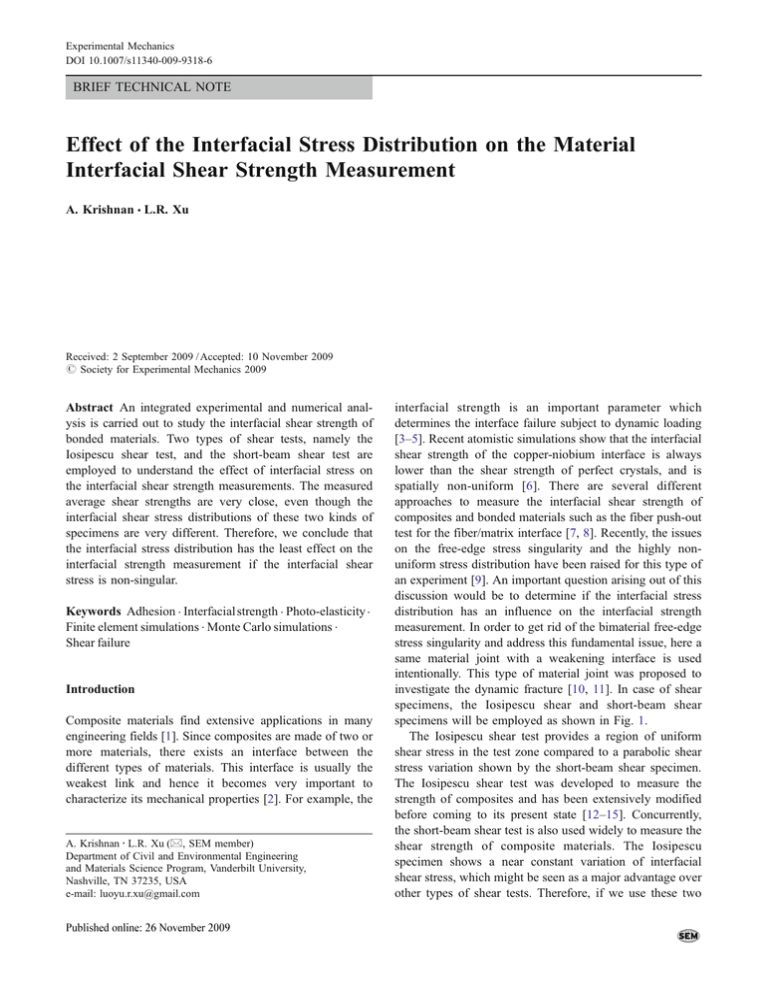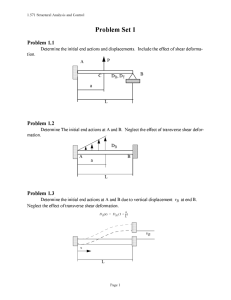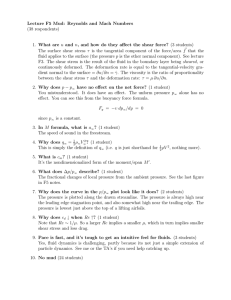Effect of the Interfacial Stress Distribution on the Material
advertisement

Experimental Mechanics DOI 10.1007/s11340-009-9318-6 BRIEF TECHNICAL NOTE Effect of the Interfacial Stress Distribution on the Material Interfacial Shear Strength Measurement A. Krishnan & L.R. Xu Received: 2 September 2009 / Accepted: 10 November 2009 # Society for Experimental Mechanics 2009 Abstract An integrated experimental and numerical analysis is carried out to study the interfacial shear strength of bonded materials. Two types of shear tests, namely the Iosipescu shear test, and the short-beam shear test are employed to understand the effect of interfacial stress on the interfacial shear strength measurements. The measured average shear strengths are very close, even though the interfacial shear stress distributions of these two kinds of specimens are very different. Therefore, we conclude that the interfacial stress distribution has the least effect on the interfacial strength measurement if the interfacial shear stress is non-singular. Keywords Adhesion . Interfacial strength . Photo-elasticity . Finite element simulations . Monte Carlo simulations . Shear failure Introduction Composite materials find extensive applications in many engineering fields [1]. Since composites are made of two or more materials, there exists an interface between the different types of materials. This interface is usually the weakest link and hence it becomes very important to characterize its mechanical properties [2]. For example, the A. Krishnan : L.R. Xu (*, SEM member) Department of Civil and Environmental Engineering and Materials Science Program, Vanderbilt University, Nashville, TN 37235, USA e-mail: luoyu.r.xu@gmail.com interfacial strength is an important parameter which determines the interface failure subject to dynamic loading [3–5]. Recent atomistic simulations show that the interfacial shear strength of the copper-niobium interface is always lower than the shear strength of perfect crystals, and is spatially non-uniform [6]. There are several different approaches to measure the interfacial shear strength of composites and bonded materials such as the fiber push-out test for the fiber/matrix interface [7, 8]. Recently, the issues on the free-edge stress singularity and the highly nonuniform stress distribution have been raised for this type of an experiment [9]. An important question arising out of this discussion would be to determine if the interfacial stress distribution has an influence on the interfacial strength measurement. In order to get rid of the bimaterial free-edge stress singularity and address this fundamental issue, here a same material joint with a weakening interface is used intentionally. This type of material joint was proposed to investigate the dynamic fracture [10, 11]. In case of shear specimens, the Iosipescu shear and short-beam shear specimens will be employed as shown in Fig. 1. The Iosipescu shear test provides a region of uniform shear stress in the test zone compared to a parabolic shear stress variation shown by the short-beam shear specimen. The Iosipescu shear test was developed to measure the strength of composites and has been extensively modified before coming to its present state [12–15]. Concurrently, the short-beam shear test is also used widely to measure the shear strength of composite materials. The Iosipescu specimen shows a near constant variation of interfacial shear stress, which might be seen as a major advantage over other types of shear tests. Therefore, if we use these two Exp Mech Y 10.3 mm 3.3 mm 20 mm Displacement X W=19.1 mm Disp 3.3 mm 10.3 mm L=38.1 mm (a) Short-Beam Shear Specimen Y 19 mm 12 mm 22 mm Displacement X W=19.1 mm 11.5 mm Displacement 12 mm 19 mm L=38.1 mm (b) Iosipescu Specimen Fig.1 Variation of interfacial shear stress for (a) Short-beam shear specimen (Parabolic shear stress variation) and (b) Iosipescu shear specimen (Near constant shear stress variation). A schematic of the boundary conditions used in finite elements (anti-symmetric) is also shown different approaches to measure the interlaminar shear strength of the same graphite/epoxy material system, should we get very different shear strengths using these two approaches due to very different interfacial shear stress distributions, or almost the same strength because the interfacial shear stress distribution has the least effect on the final shear strength? Surprisingly no one has explored this important and fundamental issue over the past 40 years (Adams DF, Private Communications, 2003). Therefore, in-depth mechanics and materials work are much needed since there are several other approaches to measure the shear strengths of composite materials [1, 16]. The objective of this study is to analyze the effect of the interfacial stress distribution on the strength measurements. In order to avoid complicated failure modes during shear tests [17], and to only focus on the shear failure of an interface, we design and test bonded polymers and metals such that the bonded interface is the only weak path leading to the final shear failure. Experimental Investigation Test specimens were made of three different types of materials including Aluminum, Polymethyl methacrylate (PMMA) and Polycarbonate. The specimens were not monolithic and were bonded from individual halves. The adhesive used in this experiment is Loctite 384. One of the key requirements in choosing the adhesive was that its bonding strength should be far lesser than that of the bulk material. The specimens were bonded at room temperature using a special fixture to guarantee their dimensionality. The individual halves were sandblasted at the bonding surfaces in order to provide good adhesion. The test set-up consists of three parts including a mechanical system to load the specimen, an optical system to develop fringe patterns and an imaging system to record the images [18]. The mechanical testing system included an MTS 810 test machine and an Iosipescu test fixture. The fringe patterns developed only in case of the transparent Polycarbonate specimens, and the isochromatic fringe patterns are the contours of the maximum in-plane shear stress [19]: t max ¼ ðs 1 s 2 Þ Nfs ¼ 2 2h ð1Þ where σ1 and σ2 are the in-plane principal stresses, N is the fringe order, fσ is the stress-fringe constant, and h is the thickness of the specimen. The imaging system included a high-resolution digital camera to capture the fringe development and a density filter in front of the camera to reduce the laser intensity. Load was applied to the movable half of the Iosipescu test fixture in the form of displacement at a rate of 1 mm/min until failure. About 25–35 specimens of each type (Iosipescu and short-beam shear) were tested in order to ensure repeatability. Almost all of the specimens failed due to shear at the interface which was necessary in this case as we measure the shear strengths. Pictures of the fringe patterns at load levels of 12.5 % (100 N) and 25 % (200 N) of failure load were taken for Polycarbonate as seen in Figs. 2 and 3, and videos depicting the development of fringes from the beginning of loading till failure were recorded. Finite Element Modeling A finite element model of the specimen was built using the software ANSYS 11.0 to obtain the stress distribution of the bonded specimen. A two dimensional analysis was considered for bonded Polycarbonate materials (Elastic Modulus of 2.4 GPa, and a Poisson’s Ratio of 0.35). A linear elastic and isotropic material model was used in this analysis. The dimensions of the specimen were: width of 76.2 mm (individual parts have a width of 38.1 mm) and a Exp Mech Fig. 2 Comparison between experimental and finite element generated fringe patterns for Iosipescu specimen made of Polycarbonate 5.4 mm Bonding Polycarbonate Polycarbonate Field of view Experimental (a) (c) height of 19.1 mm. Plane 42 elements were exclusively used in order to meet the requirements of the plotting software Tecplot. The procedure for simulating the boundary conditions was adopted similar to the method reported in [17]. In order to incorporate a realistic simulation of the load transfer from the fixture to the specimen, an iterative procedure was adopted. Displacement constraints are applied, similar to what is observed in reality. The left portion of the specimen is fixed and cannot move in the vertical dimension. The top left edge node is restrained from moving in both x and y directions in order to prevent rigid body movements. On Simulated Applied Load = 100 ± 5N Applied Load = 200 ± 5 N (b) (d) the right portion, an initial vertical uniform displacement is applied. Now the reaction loads at each of the nodes with a constraint is checked to verify that they are not in tension (in real experiments, only compressive loading is obtained). The constraint was removed from those nodes which showed a tensile reaction force instead of a compressive one, and a new analysis with the updated set of boundary conditions was carried out. This was done until convergence and the total applied load was obtained by integrating the shear stress across the bonded interface of the specimen. This procedure was iteratively carried until the required load (for matching the fringe patterns) was obtained. It should Exp Mech Fig. 3 Comparison between experimental and finite element generated fringe patterns for short-beam shear specimen made of Polycarbonate Polycarbonate Polycarbonate Bonding 5.4 mm Field of view Simulated Experimental (a) Applied Load = 100 ± 5 N (b) (c) Applied Load = 200 ± 5 N (d) be noted that the loading is anti-symmetric and remains so after every iteration. The numerical photoelasticity fringe patterns were obtained by plotting the stress distribution from the finite element analysis using the plotting software Tecplot. The maximum shear stress was obtained from the finite element analysis by using the principal stress values. Using equation (1), this stress value was then converted to a fringe order N which in turn was converted into a grayscale value. Half order fringes (0.5, 1.5, 2.5, etc.) were given a value of 255 and full order fringes (0, 1, 2, etc.) were assigned a value of 0 on the grayscale spectrum. Results and Discussion A direct comparison between the experimental fringe patterns and the fringe patterns is obtained from the numerical analysis as shown by the results presented in Fig. 2 for the Iosipescu specimen and in Fig. 3 for the short-beam shear specimen. At lower loading levels (around 100 N), the fringes begin to appear from the points of stress concentration (loading point) and begin to spread out towards the ends of the shear specimens. More fringes continue to appear as the loading is increased and the patterns are recorded on a video camera until failure. The finite element analysis captures Exp Mech all the major features seen in the experimental patterns thereby validating our finite element model and loading simulation. The interfacial shear strengths of the three kinds of bonded materials are presented in Table 1. It was observed that the average shear strengths of the two types of different shear tests were close. In the case of bonded aluminum specimens it is seen that the difference in means (between Iosipescu and short-beam shear specimens) is much lesser compared to the other two bonded specimens. In general, acrylic materials (PMMA) and metals show a better bonding in comparison with Polycarbonate which consistently gives a lower value of the interfacial shear strength. Since these two types of shear tests lead to very similar results, the short-beam shear test will have advantages like low machining and fixture cost, and shorter time for preparation. In order to provide mechanics insight into the shear failure process at the interface, Monte Carlo simulations using the initial interfacial flaw assumption were carried out [20]. The interfacial shear stress distributions at failure loads of the Iosipescu (with same cross-sectional area as the short-beam shear specimen) and the short-beam shear specimens from the finite element analysis are shown in Fig. 4. It can be seen that the variation in shear stress at the interface is parabolic for the short-beam shear specimen, but almost constant for the Iosipescu specimen. Therefore, we should briefly review the strength conception, and the stress distribution of the specimens to measure the strength. The tensile strength definition of a homogeneous material is quite straightforward: it is defined as the failure stress of a specimen with a uniform stress distribution across the cross section. Since the final failure of the material is associated with the initial defect distribution (e.g., Weibull strength distribution) at the cross section, specimens with different sizes will yield different strength data. This phenomenon may be defined as ‘the material size effect.’ In this investigation, we employed homogeneous materials but with artificial interfaces to ensure that failure will occur along these weak interfaces, thereby avoiding complicated bi-material problems in obtaining useful fundamental results [21]. Table 1 Measured interfacial bonding strengths (MPa) Specimen Type Aluminum-Aluminum Polycarbonate-PC PMMA-PMMA Fig. 4 Comparison of the interface shear stress distributions at failure load of 728 N between the short-beam shear specimen and the Iosipescu shear specimen from the finite element analysis However, for bi-materials specimens, the interfacial strength measurement becomes quite complicated due to existence of possible free-edge stress singularity [18]. Therefore, it is necessary to examine any interfacial strength experiment carefully, as otherwise it might yield meaningless data [9]. For example, the mechanics size effect (related to the stress singularity) might become coupled with the material size effect, and thus lead to complexities in interfacial strength measurement data. Hence, the measured nominal interfacial strengths cannot be used in mechanics predictions because the interfacial properties obtained from laboratory tests are very different from the real values of structures in service (size-dependent). If the free-edge stress singularity were to be successfully removed [21], a question would be whether a uniform interface stress distribution is required to measure the interfacial strength. The current investigation pointed out that the interfacial stress distribution has the least effect on the interfacial strength measurement as long as the stress is not singular. More experimental investigations are needed to verify whether this is a correct statement for all kinds of materials or not. The current work provides design guidance for future development of all interfacial strength approaches. Iosipescu Shear Short-Beam Shear 10.75±2.39 10.99±1.45 11.58±2.15 10.16±2.41 8.51±1.13 10.19±0.57 Difference 5.5 % 22.5 % 12 % Exp Mech Acknowledgements The authors acknowledge the support from the Office of Naval Research (Program manager Dr. Yapa D.S. Rajapakse) and the National Science Foundation. References 1. Daniel IM, Ishai O (2005) Engineering mechanics of composite materials, 2nd edn. Oxford University Press, New York 2. Sun C, Thouless MD, Waas AM, Schroeder JA, Zavattieri PD (2008) Ductile-brittle transitions in the fracture of plasticallydeforming, adhesively-bonded structures. Part I: experimental studies. Int J Solids Struct 45(10):3059–3073 3. Singh RP, Lambros J, Shukla A, Rosakis AJ (1997) Two optical techniques applied to the investigation of the mechanics of crack propagation along a bimaterial interface. P R Soc Lond A 453:2649–2667 4. Xu LR, Rosakis AJ (2002) Impact failure characteristics in sandwich structures. Part II: effects of impact speed and interfacial strength. Int J Solids Struct 39:4237–4248 5. Kitey R, Tippur HV (2008) Dynamic crack growth past a stiff inclusion: optical investigation of inclusion eccentricity and inclusion-matrix adhesion strength. Exp Mech 48(1):37–54 6. Wang J, Hoagland RG, Hirth JP, Misra A (2008) Atomistic simulations of the shear strength and sliding mechanisms of copper-niobium interfaces. Acta Mater 56:3109–3119 7. Bechel VT, Sottos NR (1998) Comparison of calculated and measured debond lengths from fiber push-out test. Compos Sci Technol 58:1727–1739 8. Li Z, Bi X, Lambros J, Geubelle PH (2002) Dynamic fiber debonding and frictional pushout in model composite systems: experimental observations. Exp Mech 42:417–425 9. Xu LR, Kuai H, Sengupta S (2005) Free-edge stress singularities and edge modifications for fiber pushout experiments. J Compos Mater 39(12):1103–1125 10. Rosakis AJ, Samudrala O, Coker D (1999) Cracks faster than the shear wave speed. Science 284:1337–1340 11. Xu LR, Huang YY, Rosakis AJ (2003) Dynamic crack deflection and penetration at interfaces in homogenous materials: experimental studies and model predictions. J Mech Phys Solids 51:461–486 12. Walrath DE, Adams DF (1983) The Iosipescu shear test as applied to composite materials. Exp Mech 23(1):105–110 13. Ho H, Tsai MY, Morton J, Farley GL (1993) Numerical analysis of the Iosipescu specimen for composite materials. Compos Sci Technol 46:115–128 14. Grédiac M, Pierron F, Vautrin A (1994) The Iosipescu inplane shear test applied to composites: a new approach based on displacement field processing. Compos Sci Technol 51:409–417 15. Melin LN, Neumister JM (2006) Measuring constitutive shear behavior of orthotropic composites and evaluation of the modified Iosipescu test. Compos Struct 76:106–115 16. El-Hajjar R, Haj-Ali R (2004) In-plane shear testing of thicksection pultruded FRP composites using a modified Arcan fixture. Compos B 35:421–428 17. Xu LR, Sengupta S, Kuai H (2004) An experimental and numerical investigation of adhesive bonding strengths of polymer materials. Int J Adhes Adhes 24:455–460 18. Xu LR, Kuai H, Sengupta S (2004) Dissimilar material joints with and without free-edge stress singularities: Part I. A biologically inspired design. Exp Mech 44(6):608–615 19. Kobayashi AS (ed) (1987) Handbook on experimental mechanics. Society of Experimental Mechanics, Inc. Prentice-Hall, New Jersey 20. Krishnan A (2008) Comparison of interfacial shear strength measurements for bonded materials and composite materials. MS Dissertation, Vanderbilt University 21. Wang P, Xu LR (2006) Convex interfacial joints with least stress singularities in dissimilar materials. Mech Mater 38:1001–1011






